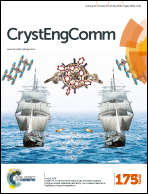Chemically activated growth of CuO nanostructures for flexible cold cathode emission†
Abstract
A generalized protocol for solution-based seeding and self-assembly of a wide range of cupric oxide (CuO) nanostructures is developed. Parameters of KMnO4 activation are found to play a crucial role in chemical seeding and vis-à-vis in evolution of various morphologies. To demonstrate the devised two-stage seeding and self-assembly protocol, various types of CuO nanostructure films are fabricated on flexible carbon fabric. Such systems are found to retain the native substrate's innate flexibility and the structural integrity of the grown nanostructures showed no deterioration upon rolling up or even twisting to a large degree. Among the various CuO morphologies, the nanoneedles exhibited excellent field-emitting traits such as a lower turn-on field of 0.9 V μm−1 and an appreciably good current density of 1.65 mA cm−2 at an applied macroscopic field of 1.25 V μm−1 as well as high stability under large applied fields. Theoretical estimation of the local electric field distribution supported the experimental outcomes and indicated that the field emission enhancement stems from the emitters' geometry as well as the spatial separation. The devised growth protocol is efficient, economic and high-throughput, thus it lays a promising path for exploiting CuO (and possibly other) nanostructures for flexible field emission electronics/displays as well as in vacuum nano-electronic devices.


 Please wait while we load your content...
Please wait while we load your content...